A new 409 proved key to getting an original-owner, special-order 1963 Chevrolet Bel Air back on the road
Quarter-mile conqueror has gone the distance
11/08/2022
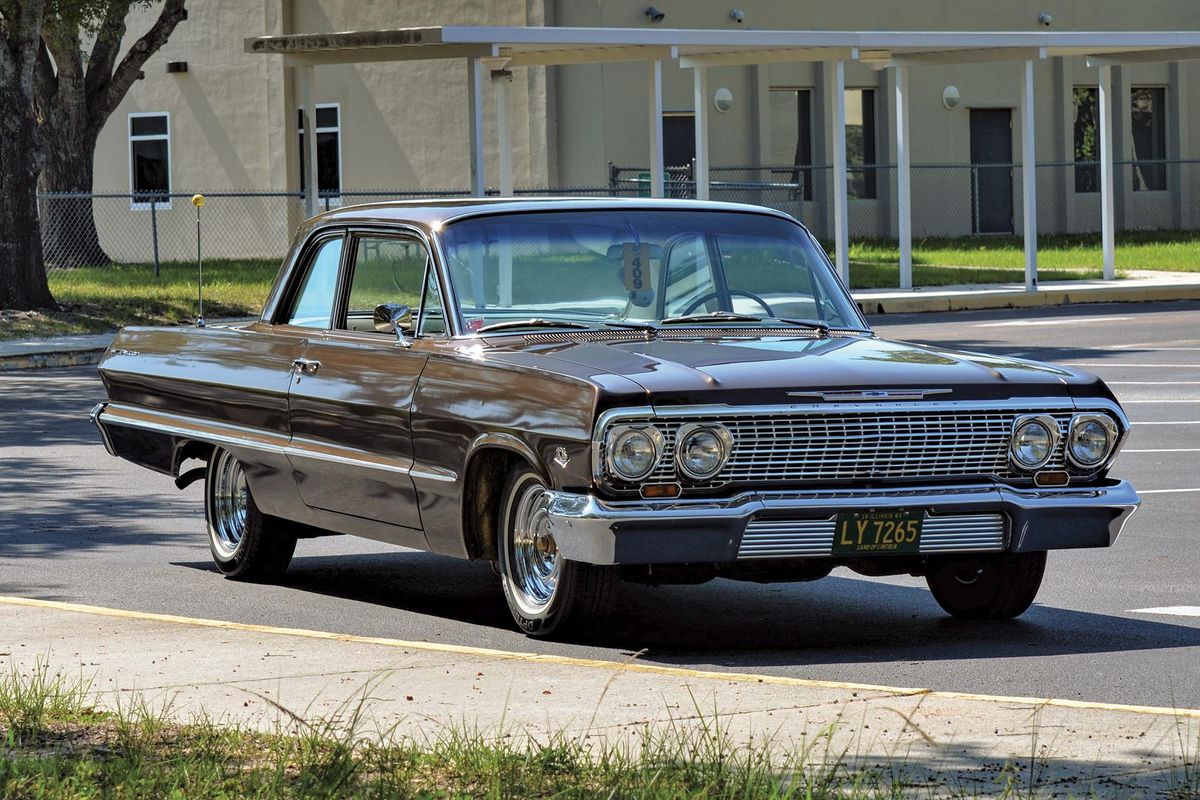
Photography by Dave Doucette
Muscle MachinesQuarter-mile conqueror has gone the distance

For any aspiring car guy in the early Sixties, hearing the Beach Boys’ “409” on the radio induced dreams of owning one of the big Chevys. Nineteen-year-old Bob Vencevich was one of those young motorheads.
Growing up in North Chicago, Illinois, Bob worked at a gas station in 1963. He owned a 1957 Chevy convertible at the time but, inspired by the Beach Boys classic, he and a friend decided one Saturday to stop by the local Chevy dealer to see a 409 in person.
“I looked around, talked to a salesman, and said ‘I want a 409,’” Bob recounts. “Everyone had a red or white one, but the book had the color chip for a metallic brown. I said that’s the color I’m gonna get.”
He decided to order the car, but the decision wasn’t that easy. “I was leery about it because I was 19, living at home,” Bob says. “What was my mom going to say?”
But he made a $20 deposit at McCallum Chevrolet in Lake Forest, Illinois, and ordered the 425-horsepower, 409-powered two-door Bel Air sedan that he still owns today. Bob ordered the Bel Air with one thing in mind: He wanted to go drag racing. Why choose the more-expensive Bel Air over a similar Biscayne, Chevy’s lighter, bottom-of-the-line model? Bob says that was an easy decision — he wanted carpet on the floor, not the vinyl covering that came in the Biscayne.
Buying the Bel Air turned into a family affair. Because Bob was just 19 at the time, his older brother’s name was on the order sheet and his mother’s name was on the dealer invoice. And his grandmother was the bank, loaning him the money to make up the difference between the price of the new Chevy and the proceeds from selling his ’57 convertible. “I paid her every week to pay off the loan,” Bob says.
He chose McCallum because the dealer was known for giving discounts for cash purchases. The original invoice confirms that point. With the options that Bob ordered, the price of the Bel Air came to $3,586.82. A $567.70 discount brought the purchase price down to $2,999.12. That’s 16 percent off retail!
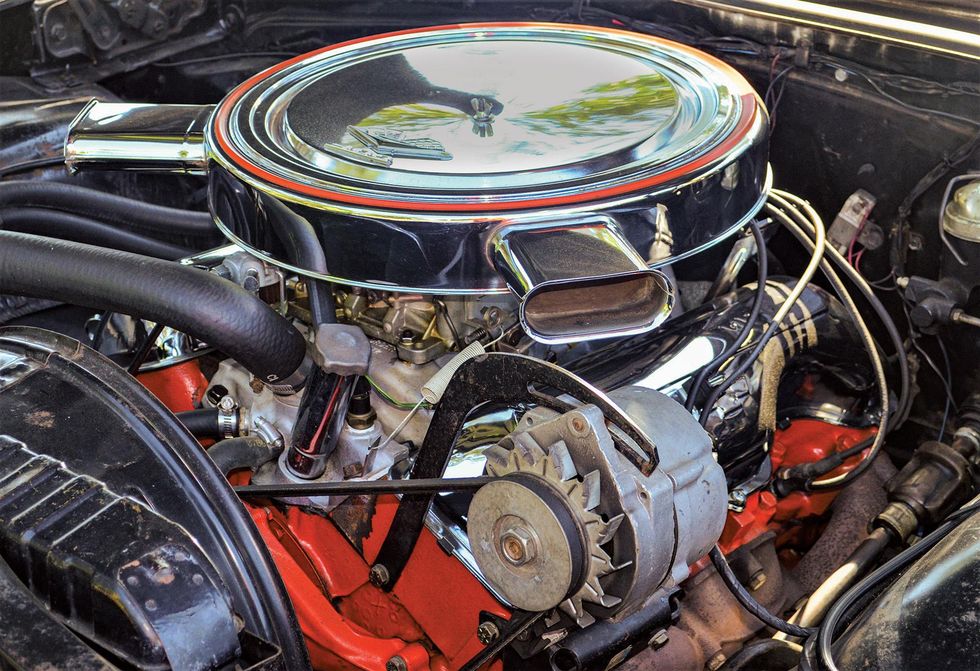
Here’s what Bob ordered: The 425-horsepower 409, four-speed manual (which included the tachometer), 4.11 Positraction rear axle, and a few creature comforts, including tinted glass, push-button AM radio with rear speaker, two-speed electric wipers, front safety belts, padded dash, and white wall tires. Bob’s color choice — Cordovan Brown — was a one-year option. It wasn’t available on 1962 or 1964 Chevys.
Bob’s special-order Bel Air was produced at the Janesville, Wisconsin GM plant. He ordered the car on June 19 and took possession about a month later on July 13. Just two months later Bob drove the Bel Air to Union Grove, Wisconsin and made his first quarter-mile run.
“I ran high 13s on street tires,” Bob says, “just to see what it would do on the stock U.S. Royals, and it burned them up.”
A month later Bob learned a lesson about the 409’s limits — especially the rpm limits.
“I didn’t know they couldn’t go past 6,000,” he says. “I floated the valves and everything went to hell.”
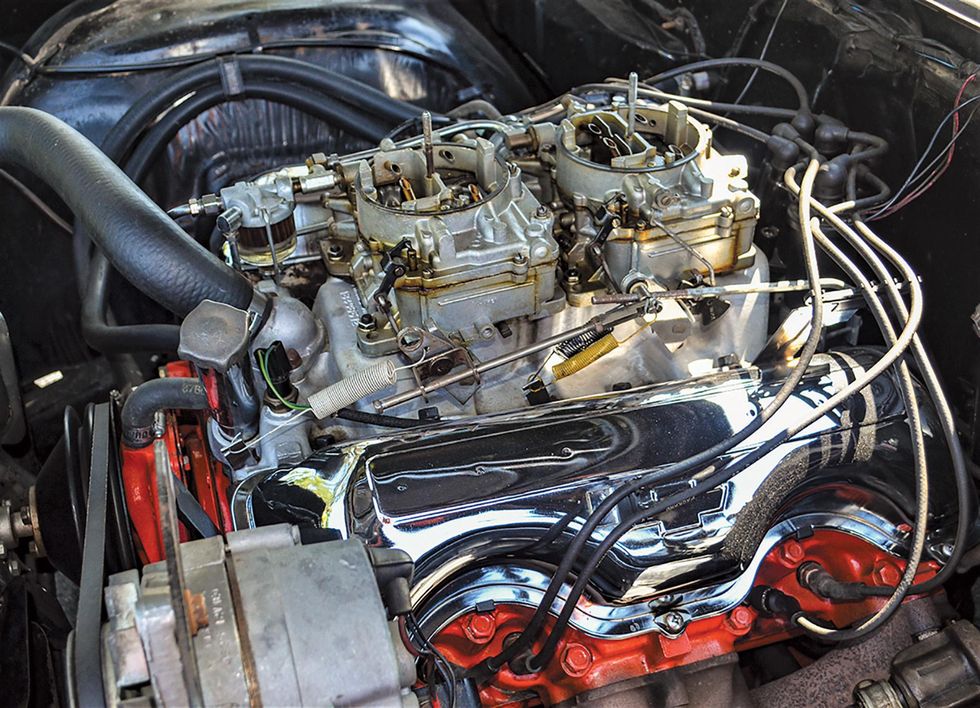
The somewhat good news? The dealer replaced the blown 409 under warranty. However, they said they’d do it just once, Bob recalls. Indeed, they didn’t cover the work the second time around, but that came a little later when the replacement 409 died. By that time, Bob was able to take advantage of his then-job as a parts manager at a Chevy dealer. The newer big-blocks were coming online in the late Sixties and Bob acquired a healthy 396 for the Bel Air.
By 1970 he was using a friend’s built 454 for power at the strip. Bob was running mid-11s on 10-inch slicks when another broken-parts situation ended the car’s drag racing career. Bob said he had to launch the car at 8,000 rpm to get it to hook up, but he shifted at 6,000 rpm.
Eventually the torque from the 454 on one of those hard launches broke both axles. The engine went back to a friend and the Bel Air, with barely 11,000 miles on the odometer, was parked. That was about the time Bob and his wife Marilyn bought their first house, so the Chevy was able to rest in the garage until 2014. Numerous people wanted to buy the car, even without the engine, but Bob wasn’t interested.
As time went on and life and work adjusted his priorities, Bob was able to use his job as a GM parts manager to acquire all the pieces required to reassemble a period-correct 409 when the time came to tackle that project.
“I had access to all the GM parts that were available,” Bob says, “Through the late-’70s and into the ’80s, I was collecting parts with the goal of putting it back together. Everything is new, and genuine GM — I used no internal aftermarket parts.”

Bob and Marilyn moved from northern Illinois to Spring Hill, Florida, during those years. The ’63 moved with them, first inhabiting the Florida home’s garage, then moving to a detached workshop where it shared space with a street rod that Bob built in the ’90s. There it hibernated until Bob succumbed to several years of encouragement from a nephew to bring the Bel Air back to life.
In 2013 his nephew journeyed to Florida, and with Bob’s help, loaded the ’63 and all the accumulated parts into a trailer for the trip back to Illinois, where the engine was reassembled. Bob spent two months at his nephew’s home working on the project.
Bob is clear to point out that the car you see today is not restored — it’s reassembled. The engine is new, but period correct. The rest of the car is original — paint, interior, trim pieces, chrome… Other than the engine, the only non-original parts are the synchronizers in the Borg-Warner four-speed and the replacement axles.
The new powerplant is based on a 1964 409 block, Bob says, since the ’63 409 block was a one-year design because of the camshaft. The heads are era-correct, as is the aluminum intake and the two Carter AFB four-barrel carbs.
Two items, though, are not stock from 1963. Early in the car’s racing career, Bob realized that the stock shifter was not up the high-stress shifts on the drag strip, so he replaced it with an iconic Hurst shifter. The chrome wheels on the car today were not an option in 1963, but Bob’s work in the Chevy parts department turned up the chromed steel wheels as a dealer-installed option in 1964.

How rare is Bob’s ’63? It’s hard to tell, because available production numbers from those early Sixties years are not as precise as they became later in the decade. However, there are hints in some of the data. If published numbers are somewhat accurate, there were more than 135,000 two-door sedans produced in the 1963 model year. There were nearly 17,000 409 engines that year in all horsepower ranges.
Numbers for the L80 option — the 425-horsepower 409 engine — indicate just less than 4,400 were produced. There doesn’t appear to be any data on how those L80 options were distributed among Impalas, Bel Airs, and Biscaynes.
So, considering the lack of detailed production breakouts, it’s not clear how many 1963 Chevys like Bob’s rolled off the assembly line. But when you consider that Bob’s Bel Air is a one-owner, 18,000-mile survivor, you’d be hard pressed to argue that there’s another one like it.
While the drag racing career of Bob’s 409 Bel Air is over, it’s still racking up the miles — just not in quarter-mile bursts. Bob and Marilyn now enjoy driving the car to local car shows and cruise nights.

SPECIFICATIONS
PRICE
Base price: $2,610.45
Options on car profiled: 425-horsepower engine, $376; four-speed transmission and tach, $236; tinted glass, $37; push-button radio and rear speaker, $75; two-speed electric wiper and washer, $17; front seat belts, $18; padded dash, $18; white wall tires (800-14), $35; Positraction rear axle, $43.
ENGINE
Block type: Chevrolet Mark I “W-series” OHV V-8, cast-iron block and cylinder heads
Displacement: 409-cu.in.
Bore x stroke: 4.3125 x 3.5 in
Compression ratio: 11:1
Horsepower @ rpm: 425 @ 6,000
Torque @ rpm: 425 @ 4,200
Valvetrain: Overhead, solid lifters
Fuel system: Two Carter AFB four-barrel carburetors, aluminum manifold, mechanical fuel pump
Electrical system: 12-volt
Exhaust system: Dual exhaust
TRANSMISSION
Type: Borg-Warner T10 four-speed manual
Ratios: 1st/2.20:1 … 2nd/1.64:1 … 3rd/1.31:1 … 4th/1.00:1
DIFFERENTIAL
Type: Chevrolet third-member type with Positraction limited-slip
Ratio: 4.11:1
BRAKES
Type: Hydraulic, single-circuit, unassisted
Front: 11 x 2.75-in drum Rear: 11 x 2.5-in drum
SUSPENSION
Front: Upper and lower control arms, coil springs, shock absorbers
Rear: Four-link-type with upper control arm, lateral control bar, two lower control arms, coil springs and shock absorbers
WHEELS & TIRES
Wheels: Chromed stamped steel (dealer-installed option in 1964)
Front/Rear: 14 x 6 in
Tires: Bias-ply white wall
Front/Rear: 8.50/D14
PRODUCTION
During the 1963 model year, Chevrolet produced 135,636 full-size two-door sedans and 16,970 409 V-8 engines; of those engines, 4,394 were L80-code 425-hp versions. It is not known how many two-door sedans received the L80 409/425-hp engine.
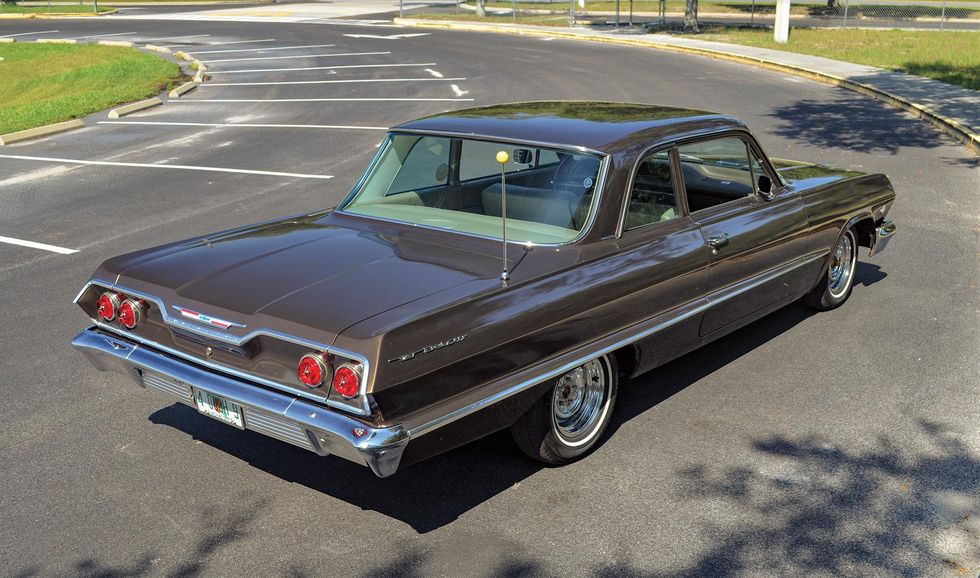
Bring up the Valiant in Mopar circles and you’ll hear associations including legendary durability, the Slant Six engine, and sporty derivatives like the Barracuda. The Valiant was an important new model for the Chrysler Corporation, one that would endure through four generations and spawn numerous variants. The first example to wear this nameplate was the standalone 1960 model (not yet badged Plymouth), which ads asserted was “Nobody’s kid brother.”
America’s automotive marketplace was rapidly changing in the postwar era, with economy-focused imports gaining inroads and domestic cars like the Rambler, Henry J, Willys Aero, Hudson Jet, and Studebaker’s Lark having earned their compact parking spots through the 1950s. The Big Three were paying attention to what was happening in the low end of market, with Chevrolet, Chrysler, and Ford each working on new models to debut for 1960. The Valiant—sold through Plymouth dealerships—would debut as a six-passenger four-door sedan in V-100 ($2,033, or $20,930 in today’s money) and V-200 ($2,110/$21,720) trims in October 1959, and be followed a few months later by the two- and three-row Suburban station wagons ($2,345-$2,546, or $24,140-$26,210).

This new model would reflect Chrysler’s famed engineering prowess. While the Rambler introduced unit-body construction to America’s small-car market years earlier, the Valiant was among the first cars whose unit-body rigidity was optimized through state-of-the-art computer-aided design and testing simulation. Under a unique, Virgil Exner-penned skin, this model proved roomy for its circa-184-inch-long size thanks to a generous 106.5-inch wheelbase. Clever touches to boost luggage capacity included a spare wheel hidden below the trunk floor in sedans and run-flat “Captive-Air” tires on wagons that made space for lockable below-deck storage or a rear-facing third-row bench.

The Valiant’s soon-to-be-ubiquitous, cast-iron Slant Six wasn’t as avant-garde as the air-cooled, horizontally opposed Corvair engine, but it was strong and clever. Canted at 30 degrees, it featured a 3.40 x 3.12-inch bore and stroke, 8.6:1 compression ratio, and a one-barrel carburetor sitting atop long, tuned intake runners. This inline-six made 101 hp and 155 lb-ft of torque, and it maintained battery charge with an industry-leading 12-volt alternator. Drive went to the rear wheels through a floor-shifted three-speed manual or pushbutton three-speed automatic.

Supporting this model was a version of Chrysler’s famous Torsion-Aire suspension, which used longitudinally mounted front torsion bars, ball joints, asymmetrical rear leaf springs, and Oriflow shocks. Behind 13-inch wheels were 9-inch drum brakes, and steering was by recirculating ball; power assist could optionally be fitted to both systems. Other desirable Valiant options included a heater/defroster, variable-speed windshield wipers, and a pushbutton radio.

The Valiant struck a chord with buyers, who purchased nearly 200,000 of the 1960 examples. This compact would come under the Plymouth brand for 1961, when two-door variants—with and without a B-pillar—were added to the lineup. Decades on, this car remains a good buy, with values that make it a very approachable collectible. Classic.com reports just one example sold publicly in the last five years, that being the original V-200 sedan that brought $3,500 in May 2023 as a Make Offer listing on Hemmings.com.

Photo: Hemmings Archives
SPECIFICATIONS
Lexus might not be the first name that springs to mind when it comes to off-road capability, but the automaker actually has a considerable history in the segment largely due to DNA shared with Toyota. In Lexus parlance, the SUVs with earnest off-road intent largely boil down to two badges: The LX, which has essentially been a gussied-up Land Cruiser since its 1995 debut, and the GX, which has shared its underpinnings with the 4Runner since its introduction in 2002.
For the GX, that development strategy turned out to be a bit of a double-edged sword. The use of the Toyota F2 platform provided the GX with the 4Runner’s truck-like body-on-frame construction and chassis layout, and paired with an air suspension setup and various electronic assistance systems, it gave the first-generation GX significantly more off-road prowess than its soft-roader appearance might have suggested.
The flip side of the coin is that, since the 4Runner remained on the same platform for more than twenty years, so did the GX. So, much like the 4Runner, the GX has been in desperate need of an extensive overhaul for some time.

The new twin-turbocharged 3.4-liter V6 dishes out 349 horsepower and 479 pound-feet of torque. These figures represent gains of 48 horsepower and 150 pound-feet of torque over the naturally-aspirated V8 in the outgoing GX.
Photo: Bradley Iger
Now, at long last, the GX has received that comprehensive update. Built on Toyota’s new TNGA-F body-on-frame platform – which is shared with the all-new Tacoma, Land Cruiser, and 4Runner, among others – the new GX550 boasts a wheelbase that’s 2.36-inches longer than its predecessor, while its width has increased by 3.74 inches for Premium and Luxury trims (or 4.52 inches for Overtrail models). The larger footprint is complemented by a boxy exterior design that gives the GX a much more aggressive look, and it backs up the new aesthetic with revamped technology throughout.
The question is, can the GX550 make good on its purposeful appearance with legitimate off-road chops? And perhaps more importantly, can it do so while still delivering the luxurious on-road driving experience that we’ve come to expect from Lexus SUVs? We grabbed the keys to this Overtrail+ model and hit the road to find out.

18-inch alloys with 33-inch Toyo Open Country all-terrain tires are standard on Overtrail and Overtrail+ models.
Photo: Bradley Iger
While the angular sheet metal inherently gives the new GX550 a more macho demeanor than the outgoing GX, the new Overtrail trim really takes things to the next level. Rolling on 18-inch alloys wrapped in 33-inch Toyo Open Country all-terrain tires, the model’s unpainted fender flares, front skid plate, and two-tone paint give the SUV a beefy, just-right look.
But don’t mistake this for some glorified appearance package: Further bolstering the Overtrail’s off-road credentials is the Electronic Kinetic Dynamic Suspension System (E-KDSS), which automatically and independently adjusts the front and rear sway bars as needed to improve wheel articulation. A locking rear differential and a locking Torsen limited-slip center differential are also on board, as is a two-speed transfer case.
Our Overtrail+ tester is motivated by a 3.4-liter twin-turbocharged V6 that sends 349 horsepower and 479 pound-feet of torque to all four wheels through a 10-speed automatic gearbox, a combination that provides a maximum towing capacity of 8,000 pounds. Lexus says that a hybrid will be offered further down the line, but for now, all GX550 models will use this powertrain. The suspension consists of a double wishbone setup up front and a solid axle with a coil-sprung four-link at the rear, while active dampers provide the ability to soften or stiffen the suspension as needed.

Photo: Bradley Iger
The cabin, meanwhile, is geared a bit more toward the expectations of a traditional Lexus buyer. A new 14-inch touchscreen infotainment display also finally does away with Lexus’s abysmal trackpad controls. The system boasts sharp graphics and quick response, along with wireless Apple CarPlay and Android Auto compatibility. And in the case of our tester, it’s matched up with a bangin’ 21-speaker, 1,800-watt audio system as well as a wireless charging pad that, unlike many we've tested in recent memory, kept our phone charged without overheating issues or the need to constantly re-position the mobile device.
The layout of the switchgear is pleasing to the eye, and we’re thankful that Lexus hasn’t entirely abandoned physical controls, but the amount of similarly-sized knobs at arm’s reach had us grabbing the temperature adjustment to lower the volume of the stereo and attempting to start the engine by pressing the drive mode knob. We also found it frustrating that nearly all of the HVAC adjustments are now made through the infotainment system, and the need to make those settings available at all times means that they always occupy about a third of the screen’s available real estate.
But the Overtrail+’s heated, ventilated, and massaging front seats make these indiscretions easier to forgive, and aside from the utilitarian rubber floor mats and chintzy-feeling glove box door, everything you see and touch has a decidedly luxurious vibe to it.
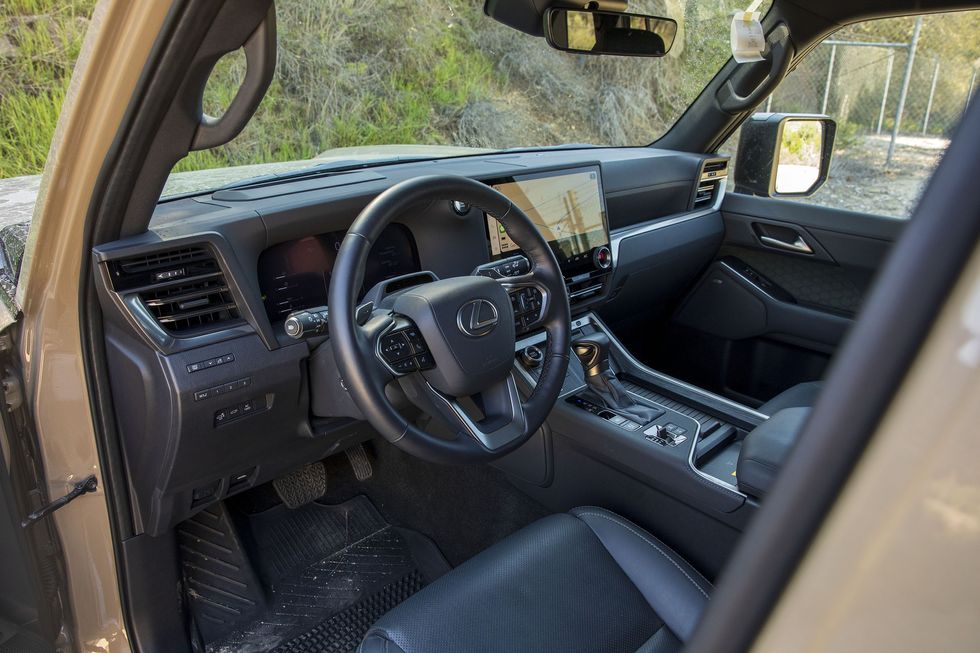
While Premium and Luxury trim GX550s offer seating for up to seven passengers, Overtrail owners are limited to five, as opting for the more off-road-focused trim requires forfeiting the third row.
Photo: Bradley Iger
On the road, the GX550 Overtrail+ is better behaved than the squared-off bodywork, tall stance, and chunky tires might suggest. While the latter doesn’t do the handling any favors (which in turn makes the inclusion of a Sport+ drive mode seem a little overly optimistic), the GX550 Overtrail+ tracks straight on the highway and requires few corrections to keep it on the intended path.
Aside from some faint wind noise that’s likely the result of the big side mirrors and the flat, steeply-angled windshield, the GX550 is nearly silent at speed. The torquey (and decidedly thirsty) boosted V6 and the ten-speed gearbox are generally happy to do their work quietly in the background. The pair provide noticeably more passing power than the naturally-aspirated V8 and six-speed transmission in the outgoing GX, but don’t expect mind-blowing acceleration here.
The new sport-utility features six drive modes – ECO, Comfort, Normal, Sport, Sport+, and Custom. We found ourselves leaving the GX in its default mode most of the time, though we occasionally switched over to Sport for more urgent powertrain response and tauter road manners at times when we needed to quickly make our way around slower traffic. Thanks in part to the Toyos’ substantial sidewalls, the GX550 Overtrail’s on-road ride quality never felt remotely abusive regardless of the road surface or the drive mode selected.
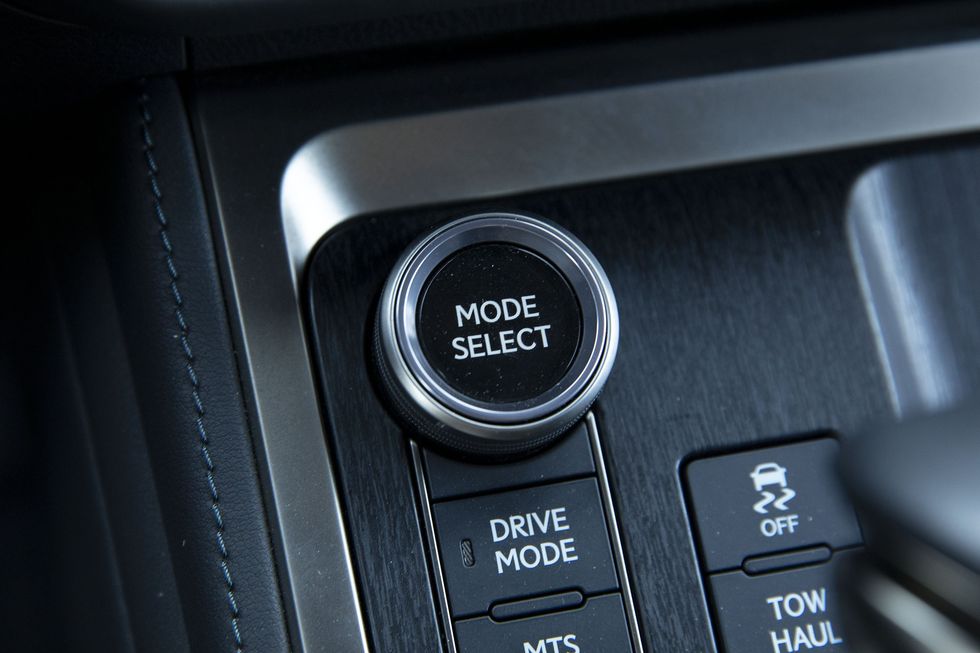
The Multi-Terrain Select system offers Deep Snow, Mud, Sand, Dirt, and Auto modes to keep the off-road guesswork to a minimum.
Photo: Bradley Iger
But it should come as no surprise that off-road park is really where the GX550 Overtrail+ proves its worth. Located about an hour north of downtown Los Angeles, Hungry Valley is a venerable candy land of off-road trails. We tested a Chevrolet Silverado ZR2 Bison here just a few months ago, but in the time since, winter storms have amplified the challenges with deeper mud pits, steeper inclines and drops, and bigger ruts.
The GX550 dispatched virtually all of it without complaint. Features like Crawl Control and Downhill Assist Control made particularly tricky obstacles and otherwise-sketchy descents feel effortless, while the Mutli-Terrain Select system eliminated the need to figure out the right combination of settings for the situation at hand. However, we did note that the approach, breakover, and departure angles of 26/24/22, respectively, pale in comparison to the Land Rover Discovery – let alone similarly priced versions of the Jeep Wrangler and Ford Bronco – and the non-retracting running boards were occasionally cause for concern in especially demanding sections.
Still, there’s no question that this is a very capable overlanding machine, and the hardware that Lexus has outfitted it with make its on-road manners all the more impressive. Paired with its sharp aesthetic and luxury amenities, the GX550 marks a huge step forward for the GX line, and the new Overtrail trim just makes it an even more compelling proposition.